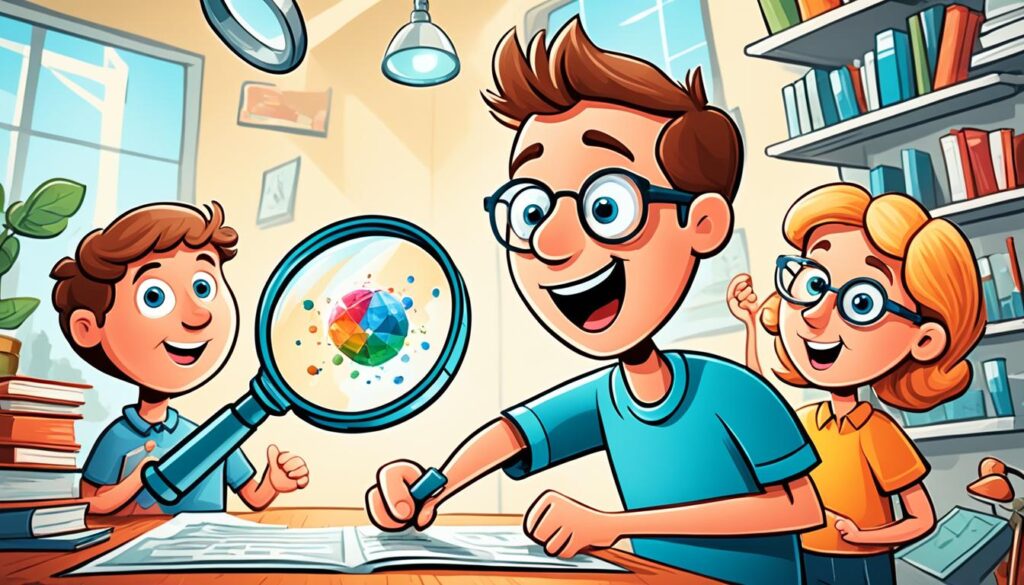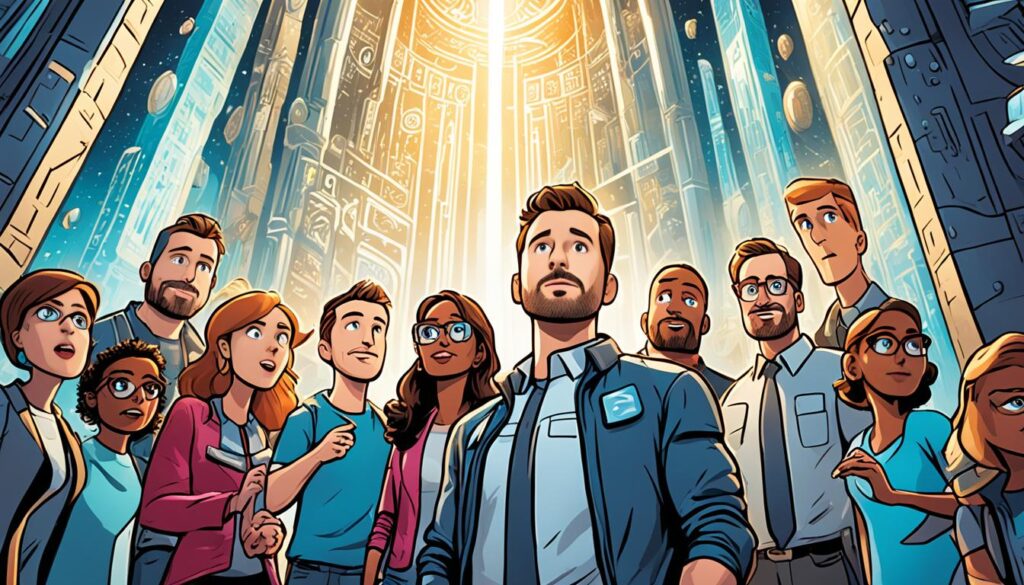Have you ever felt a spark of curiosity? It’s that rush of excitement that encourages you to explore unknown places. Curiosity isn’t just a simple feeling; it’s a powerful force that can change your world completely.
By welcoming curiosity, we step into a realm full of opportunities. It makes us eager to learn, explore, and expand our horizons. Curiosity helps us move beyond our usual boundaries and discover new aspects of the world.
So, what is curiosity, and how does it function? Studies show1 curiosity is more than a temporary interest. It’s essential for a data visualization designer, highlighted as a key quality over two years ago.
But curiosity’s effect extends far beyond data visualization. It’s found to enhance our thinking and problem-solving skills. One study proves this point, showcasing curiosity’s deep impact on our brains1.
Curiosity also enriches how we connect with the world. Robin Kwong talks about increasing news interest through curiosity. It’s a way for journalists to grab attention and spark a thirst for knowledge1.
Curiosity can drive us to achieve specific goals, like studying unemployment trends. With curiosity, we discover underlying patterns and insights, leading to breakthroughs1.
Additionally, curiosity can immerse us completely in what we’re doing, creating a sense of accomplishment. This feeling of intense focus stems from our natural urge to seek and learn1.
Now, you may wonder how to apply curiosity to change your world. Look at the New York Times’ interactive “You Draw It.” These are prime examples of curiosity’s power to inform and engage1.
Consider the impact of curiosity measured in 2011 through return on effort in graphics. It shows the significance of arousing curiosity before revealing answers. This approach emphasizes curiosity’s valuable role in graphic design1.
Curiosity drives us to confront challenges and find solutions. Embracing a curious mindset unlocks our potential for personal growth. It’s about diving into the unknown, asking questions, and discovering answers that lead to our development.
Key Takeaways:
- Curiosity is a powerful force that can transform your world by sparking creativity, fueling growth, and fostering personal development.
- Curiosity is a core trait of a data vis designer, impacting reasoning abilities and influencing engagement with the world.
- Curiosity can lead to a state of flow and is exemplified in successful interactive graphics like “You Draw It” from the New York Times.
- The concept of return on effort highlights the impact of making readers curious before delivering answers in graphic design.
- Embracing curiosity empowers individuals to solve problems and embark on a journey of personal transformation.
The Benefits of Deep Curiosity
Exploring deep curiosity can change your life for the better. By diving deep into it, you begin a path of learning about yourself and the people around you2. This understanding brings empathy and compassion, letting you connect more deeply with others. Embracing this curiosity opens you to new views and ideas. It broadens your world and sharpens your ability to solve problems2.
Deep curiosity sparks a desire to learn that never ends. It drives you to find new info and experiences. This constant quest keeps your mind open and ready to marvel at life. It encourages you to try new ways of thinking and doing things2.
Studies show that deep curiosity can make your life more fulfilling. Always searching for knowledge helps you find meaning and purpose. This journey can lead to happiness and a sense of satisfaction in life2.
It also improves your relationships. Being genuinely curious about others deepens the bond you have. Listening well and asking meaningful questions help build respect and understanding. These actions make your relationships stronger3.
Deep curiosity positively affects both personal and work life. It helps you adapt and find innovative solutions during tough times. This leads to better decision-making and deeper thinking2.
The Benefits of Deep Curiosity:
| Benefits | Statistics |
|---|---|
| Gaining a deeper understanding of oneself and others | 2 |
| Promoting empathy and compassion | 2 |
| Enhancing problem-solving skills | 2 |
| Encouraging lifelong learning | 2 |
| Increasing open-mindedness | 2 |
| Improving well-being and overall satisfaction | 2 |
| Strengthening relationships | 3 |
| Impacting enterprise performance | 2 |
By diving into deep curiosity, you open the door to endless growth and change. It is a key element for achieving great things in life. So, keep your curiosity alive. Seek out new adventures and keep learning. This is how we all truly flourish.
The Power of Detaching and Letting Go
Detaching from assumptions and biases helps us explore deeply. It’s about shedding old thoughts and embracing new views4. By doubting our own biases, we stay away from judging quickly. This fosters a curious and understanding mindset4.
Detachment breathes life into connections and invites growth. Approaching things with an open heart and mind leads to richer experiences.
Letting go of what holds us back is key to our mental health. It helps us drop the weight of negative feelings4. These weights could lead to sadness or worry. Keeping distance in relationships lets others own their decisions4. This approach builds stronger, healthier boundaries.
When we don’t cling to expected results, we break free from our own limits. Embracing the unknown reduces our impatience and dissatisfaction4. Detachment brings joy and peace in the moment4. Accepting uncertainty opens us to change and freedom.
Letting Go of Attachment: Lessons from Real-Life Examples
Seeing how others handle attachment is revealing. A 92-year-old shows how letting go brings peace5. Another, at 88, suffers from clinging to the past5. These stories teach us that letting go can bring tranquility.
Studies show that holding on too tight leads to struggle5. Choosing to accept life as it comes can make things smoother5. Learning to detach can make our lives healthier and more rewarding.
The Importance of Intention in Curiosity
Intention is key to really diving deep into curiosity. By deciding to stay curious and open-minded, we set ourselves up for growth6. When we look at things wanting to learn and see more, we open doors to new experiences.
Being intentional means being fully there and into what makes us curious. It means really paying attention to what’s happening now and diving deep into the experience6. This way, we can truly understand and learn from what we see and hear.
It’s also important to make the right setting for curiosity. This means making a space where asking questions and sharing ideas is encouraged6. When we set aside time to ask and learn, curiosity grows in this special space.
Having intention with curiosity lets us face new things with an open heart and purpose. It helps us embrace the unknown and seek the answers we’re looking for6. With intention leading us, we start on a path full of growth and new discoveries.

References:
- Statistical Data
| Statistical Data | Description |
|---|---|
| Institute for Advanced Study | 33 Nobel Laureates and 41 out of 56 Fields Medalists affiliated with the Institute. |
| The book “The Usefulness of Useless Knowledge” | 104 pages, published in February 2017. |
| Flexner’s essay “The Usefulness of Useless Knowledge” | Advocates curiosity-driven scholarship and cites the example of Professor Clerk Maxwell and Heinrich Hertz’s experimentations leading to the invention of the wireless radio by Guglielmo Marconi. |
| Benefits | Statistical Data Reference |
|---|---|
| Career Longevity | 12 |
| Learning Agility | 12 |
| Organizational Flexibility | 12 |
| Psychological Benefits | 12 |
Being curious can help you in many ways. It can make your career last longer and help you learn faster. You become flexible at work and enjoy psychological benefits. Curiosity can open many doors to both personal and professional growth.

Curiosity is something everyone can develop, not just a few. By being curious every day, you start exploring and discovering more about yourself. This journey makes your life richer and more enjoyable.
The Connection Between Curiosity and Personal Well-being
Curiosity is not just an interest; it deeply affects how well we feel. Studies15 reveal that curious people often feel happier and more satisfied with their lives. They experience better wellness overall.
Being curious fills life with meaning and purpose. It pushes us to learn and find new things, bringing joy and fulfillment. Curious minds are more involved and mindful, letting us enjoy our world’s beauty.
Curiosity boosts our mood by sparking wonder and excitement. This feeling can make us happier and positively affect our wellness16.
It also cuts down stress and worry. Curious people focus on new ideas instead of dwelling on negative thoughts. This outlook can make us feel calmer and enhance our well-being.
Plus, curiosity is key for personal growth. It helps us gain more knowledge, skills, and views. By staying curious, we keep learning and adapting, ready for changes in life15.
Curiosity also improves how we make decisions and solve problems. With an open mind, we look for more information and different solutions. Better choices and solutions boost our well-being16.

| Benefits of Curiosity on Personal Well-being | Data Source |
|---|---|
| Higher levels of life satisfaction, happiness, and overall well-being | 15 |
| Promotes a sense of purpose and meaning in life | 15 |
| Enhances positive emotions, reducing stress and anxiety | 16 |
| Contributes to personal growth and development | 15 |
| Improves decision-making and problem-solving abilities | 16 |
Overall, being curious hugely improves our well-being. By keeping a curious mindset, we enjoy a more fulfilling life. Curiosity leads us to discover ourselves, learn endlessly, and grow personally.
Curiosity as a Catalyst for Growth and Transformation
Curiosity helps us grow and change. It makes us eager to learn new things and question what we know. This takes us out of our comfort zones. It leads to discovering new chances, gaining various experiences, and seeing things differently. All of these help us grow personally and professionally.
Studies show that being curious lights up parts of the brain that make us feel good17. It also helps us remember things better17. When we’re very curious, our brain releases dopamine, which makes us feel happy17.
Curiosity comes from our minds and bodies17. A little cortisol, a stress hormone, can make us more curious17. So, both what’s inside us and what’s around us drive our curiosity.
When learning, being curious helps us remember things better17. Letting learners choose what to learn increases their curiosity and attention17. Using different ways to teach, like videos or eLearning, keeps learners interested17. Making learners eager for what’s next also helps17.
Curiosity not only helps us grow but also makes us more creative. It shows us that creativity is a journey with lots to learn and surprises along the way18. Curious artists create new and challenging art18. By being curious, we live a fulfilling and creative life, changing for the better18.
Being curious makes us excited and open to new experiences18. It helps us stay interested and driven18. Openness, adaptability, and resilience are key traits of curious and creative people18.
Curiosity changes society too. Asking questions sparks curiosity and lifelong learning19. It helps us think critically and make smart choices19. Questions open our minds, fighting narrow thinking and making us more inclusive19. They lead to creative solutions and push progress19. Reflecting on questions helps us grow personally and build stronger relationships19. Thoughtful questions can inspire actions that change the world19.
The Transformative Power of Curiosity
Curiosity is a powerful force for change and growth. Embracing it means exploring, learning, and creating endlessly. It pushes us out of our comfort zones to discover new things and make positive changes. Curiosity drives us forward, changing us and the world for the better.
The Role of Curiosity in Building Strong Relationships
Curiosity is key to strong, meaningful relationships. It shows you care about others and their views. This can build trust, understanding, and empathy.
Curiosity leads to great conversations, closer connections, and a feeling of belonging. It celebrates differences and promotes a caring, inclusive world.
Show curiosity to make others feel valued. Ask questions and really listen. This builds respect and opens the door for honest chats.
Research shows20 how important being curious can be. It mentions wide interests, like poetry and martial arts, boosting personal growth.
Trying out new hobbies can help in your career later on20. Exploring different areas lets you see new viewpoints and become more rounded.
Curiosity finds links between different interests20. This search for knowledge can lead to new insights and personal development.
Studies show21 curiosity is essential for learning and evolving. It drives discoveries and cultural progress. Early life experiences play a big role in fostering it.
Curiosity helps find your “Big Idea” and guides your growth20. It keeps you eager to learn, adapt, and remain open to new things.
In the workplace, curiosity strengthens relationships22. It’s crucial for tech job hopefuls. Those who show curiosity about the field often stand out22.
Asking about customer needs is key in tech sales22. This shows you’re genuinely interested in helping them.
The Transformative Power of Curiosity
Curiosity can change you and society for the better. It leads to self-discovery, growth, and connecting with people. By sharing and appreciating each other’s curiosity, we encourage learning and build strong relationships.
| Benefits of Curiosity in Building Strong Relationships |
|---|
| 1. Fosters trust, understanding, and empathy |
| 2. Sparks meaningful conversations |
| 3. Deepens connections |
| 4. Creates a sense of belonging |
| 5. Celebrates diversity and bridges differences |
| 6. Promotes inclusivity and compassion |
Curiosity lets you see the value in others’ stories and ideas. By keeping it alive, we push for more growth, connections, and a better world.

The Transformational Time of Curiosity in Society
Curiosity is a powerful force that can reshape our world. It encourages us to grow and understand one another, building a community that cares and shares. Curiosity pushes us to imagine, create, and work together in all fields. It helps us fight unfairness, break old patterns, and ensure everyone is treated fairly, making our society better for all.

Curiosity leads to new ideas and solutions. It questions old ways and searches for better paths forward. It leads us to discover new places, ideas, and ways to make our world more caring for the planet23.
| Benefits of Curiosity in Society | Statistics |
|---|---|
| Sparking Innovation | Curiosity motivates individuals to seek new knowledge, connections, and perspectives, driving innovation and technological advancements. |
| Promoting Diversity | By fostering inquisitiveness, curiosity brings diverse viewpoints together, fostering meaningful discussions and enhancing problem-solving processes. |
| Cultivating Change | Thought-provoking questions and curiosity fuel transformative shifts on individual and societal levels, leading to positive change. |
| Encouraging Critical Thinking | Curiosity serves as a catalyst for critical thinking and evaluating information and ideas, enabling individuals to make informed decisions. |
| Promoting Personal Development | Through reflective questions, curiosity facilitates self-awareness, personal growth, and a deeper understanding of oneself and others. |
Encouraging curiosity makes a big difference in society. Schools are key in this journey, putting curiosity at the heart of learning. Programs like British Gas’s Generation Green take big steps by helping over 10,000 schools inspire young minds to be curious about our world and how to protect it23. Teaching kids to be curious prepares them to build a brighter tomorrow.
The Connection Between Curiosity and Personal Well-being
Studies show curiosity does wonders for us, too. It drives us to learn, discover, and grow. Curiosity keeps our minds active as we search for answers and think deeply about the big questions, helping us understand both the world and ourselves better24.
Plus, curiosity brings us closer to others. It sparks deep talks and connections, making us more empathetic and united24. These bonds are important. They help us collectively face challenges and strive for a shared purpose.
Curiosity also makes us happier at work. With more time for ourselves, we stress less and do better. Iceland tried a shorter workweek, and it was a huge success, showing that when we have a healthy work-life balance, everyone wins25. It proves that exploring new work ideas can lead to happiness and success at both work and home.
In essence, curiosity has the power to change our society deeply. By valuing and encouraging curiosity, we can drive positive change, create new things, and become a kind, understanding community. It’s the key to challenging what we know, achieving fairness, and growing as both individuals and societies. Let’s let curiosity lead us to a hopeful, bright future.
Conclusion
Curiosity is a strong force that can change your world. Embracing it helps you grow and find more joy in life. It sparks creativity and leads to a better life.
By asking questions and exploring, you can connect ideas from different areas. This helps bridge gaps, build empathy, and bring positive changes. Curiosity is your key to discovering amazing truths and reaching your full potential.
So, let curiosity guide you. See how it changes your life and the world262728.,,











